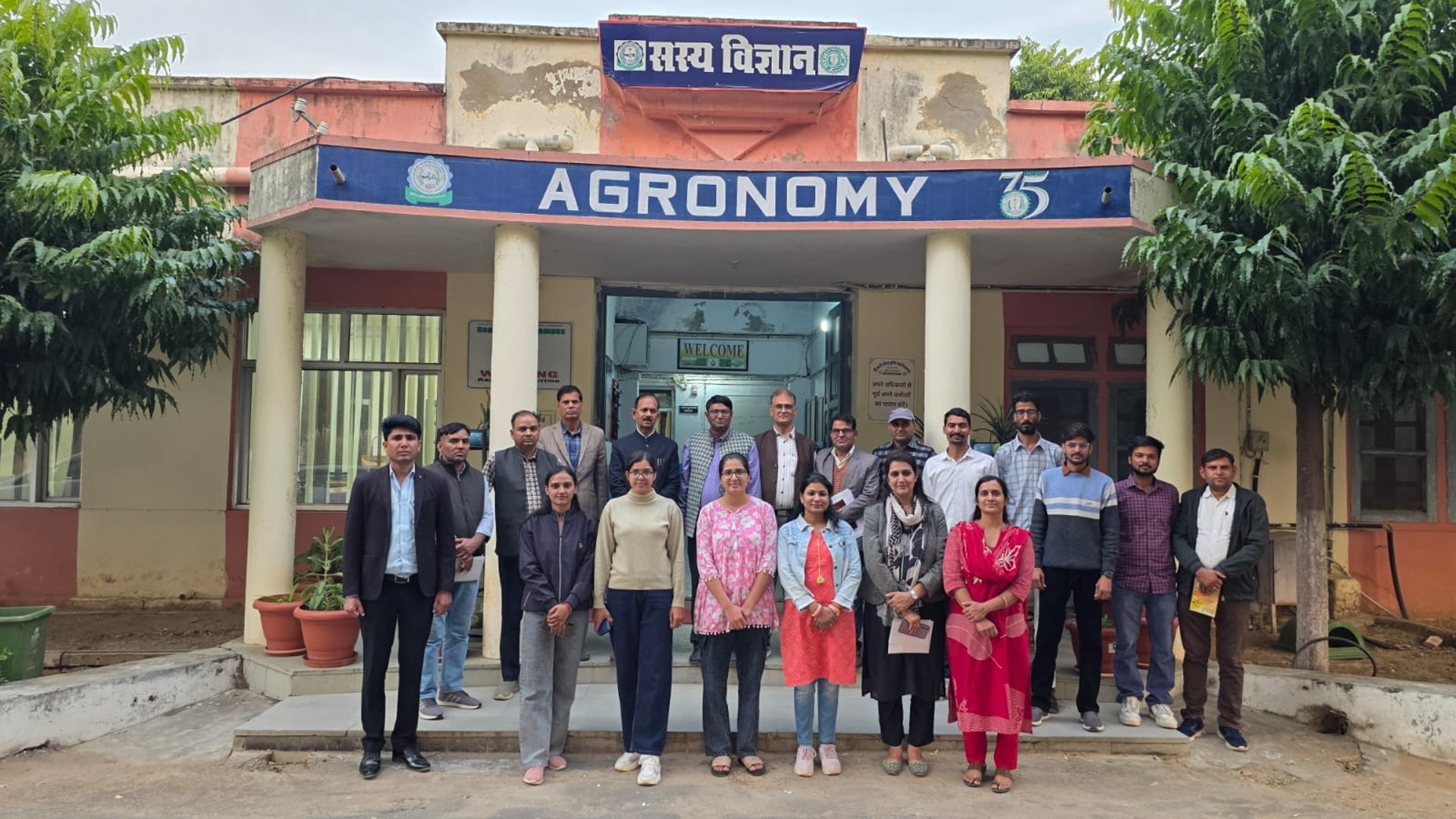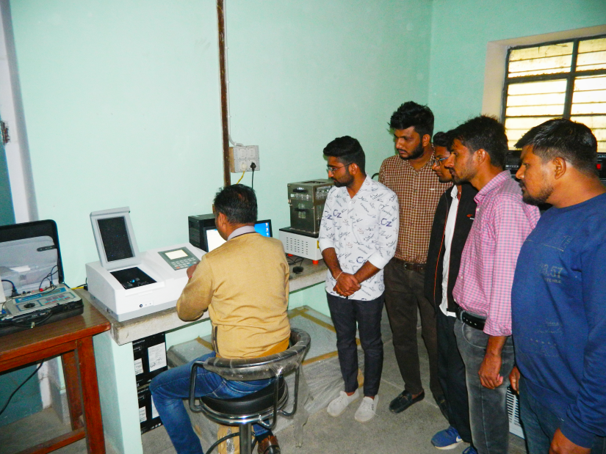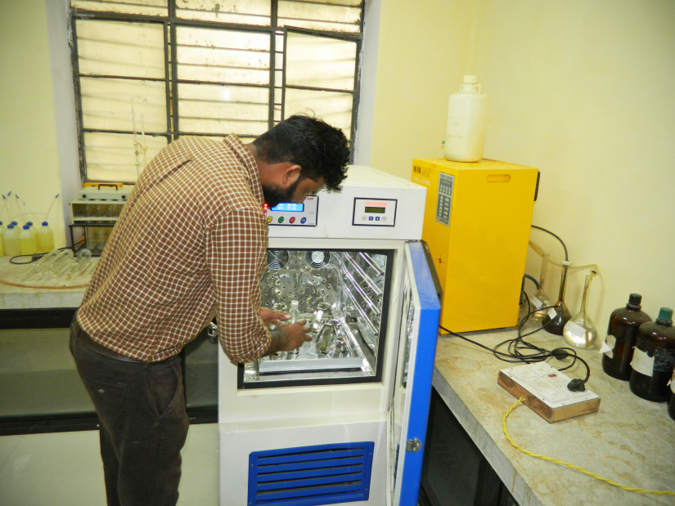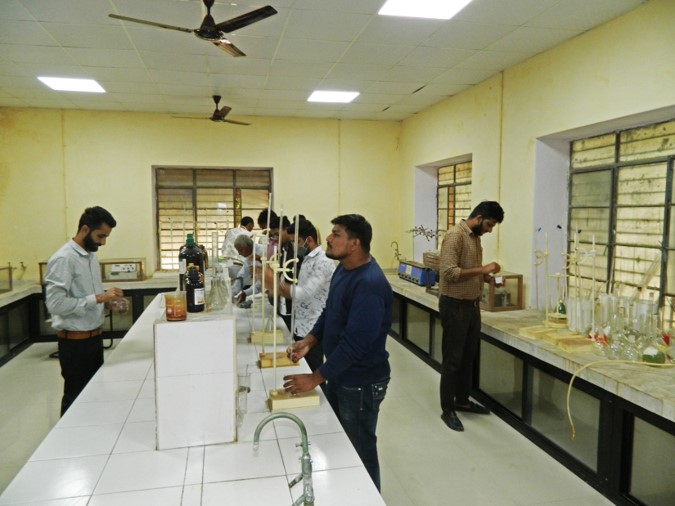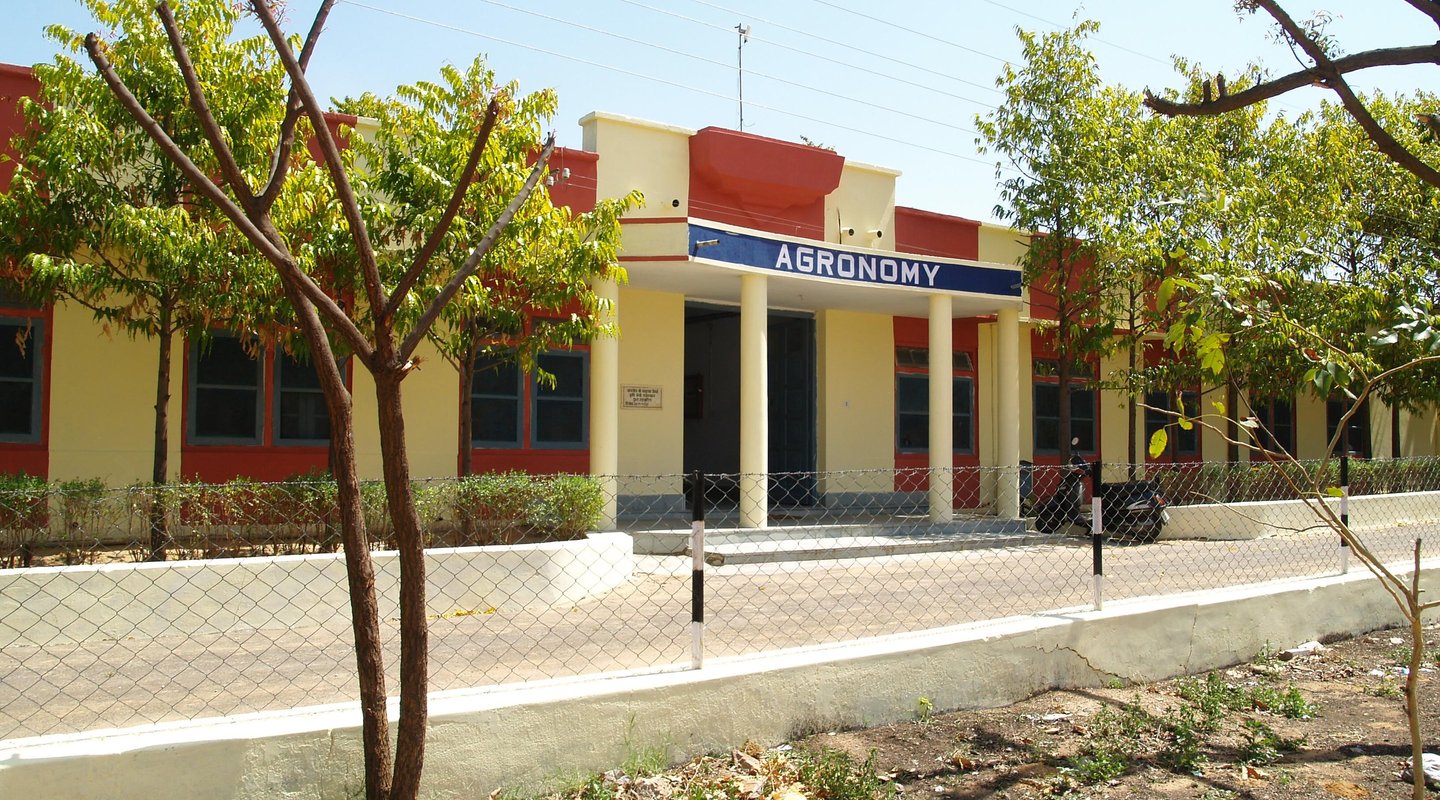

Department of Agronomy
Introduction
Department of Agronomy is one of the oldest Department and started functioning from 10th Feb., 1948. The PG programme i.e. M.Sc. in soil and water conservation and Ph. D.(by thesis) started during 1966. The full fledged M.Sc and Ph.D (by course work) were started in 1975 and 1997, respectively. The Department is not only imparting teaching to under graduate and post graduate students but also takes active part in research and extension activities.
Objectives
To impart education in agronomy
To undertake research work in agronomy
To deliver training to farmers/ officers/ staff of agriculture Department
To undertake such other works, the college or university may be deem proper to fulfil the objective
The faculty members of this Department are fully engaged in imparting quality education to UG and PG students. As a result, sufficient number of students got qualified in Agronomy and admitted in reputed institutions including IARI, New Delhi. This Department is also known for placement of students. Most of the students passed out from this Department got government job and some of the students also started business in the field of agriculture.
Students in Department of Agronomy
Number of Post graduate Students produced so far: 380
Number of Ph. D. Students produced so far: 67
Number of post graduate student registered at present-16
Number of Ph.D. student registered at present-15
Research activities
More than 20 ad-hoc research projects funded by ICAR / state government / private companies and collaborative projects with other institutes have been completed by the faculty of the Department.
About 77 recommendations of the research activities have been included in the package of practices of the zone during last five years. Faculty and students of the department got some awards and recognitions and published more than 176 research papers, book chapters, review papers, etc. during last five years.
Ongoing adhoc research Projects
Organic Farming for Sustainable Crop Production and better Health (Rs. 260.89 lakh)
Standardization and Characterization of Liquid Organic Formulations (Rs. 56.56 lakh)
Name: Dr. S.S. Yadav
Designation: Professor & Head
Specialization:
Contact: 9414820578
Email: hod.agro@sknau.ac.in
AEIS Profile Link:
Staff Information


Name: Dr. D.K. Jajoria
Designation: Professor
Specialization: Organic Farming
Contact: 9413049248
Email: dineshjajoria.agro@sknau.ac.in
AEIS Profile Link:


Name: Dr. B.L. Dudwal
Designation: Assistant Professor
Specialization: Conservation Ag. & Crop Diversification
Contact: 8290480713
Email: bldudwal.agro@sknau.ac.in
AEIS Profile Link:


Name: Mr. B.R. Meena
Designation: Assistant Professor
Specialization: Medicinal Crops
Contact: 9982787922
Email: brmeena.agro@sknau.ac.in
AEIS Profile Link:


Name: Sh. Gopal Kumawat
Designation: Class-IV
Specialization:
Contact: 9461822058
Email:
AEIS Profile Link:
Name: Ms. Sumitra Devi Bhamboriya
Designation: Assistant Professor
Specialization:
Contact:
Email: sumitra.agro@sknau.ac.in
AEIS Profile Link:


Details of Former Heads
Recent Awards:
1. Dr. A.K. Gupta, was conferred Gold medal by Indian Society of Agronomy in national symposium of ISA in 2023.
2. Dr. A.K. Gupta and Dr. L.R. Yadav were awarded fallow of Indian Society of Agronomy for the year 2018 & 2020, respectively in the fifth International Agronomy Congress held at PJTSAU, Hyderabad during 23-27, Nov. 2021 for their outstanding contribution in the discipline of Agronomy.
3. Dr. H.P. Verma student of this department was also awarded best Ph.D. Thesis award for year 2017 by Indian Society of Agronomy during fifth International Agronomy Congress held at PJT SAU, Hyderabad during 23-27, Nov. 2021.
4. Dr. A.C. Shivran, Professor and Head was awarded fallow of Indian Society of Agronomy for the year 2018 their outstanding contribution in the discipline of Agronomy.
5. Dr. A.C. Shivran, Professor and Head was given First Award for Best Poster presentation in Rajasthan Science congress held at SKNAU, Jobner in 2022.
6. Dr. A.C. Shivran, Professor and Head was awarded Fellow for the year 2014-2015 of The Indian Society of Seed Spices, NRCSS, Ajmer
7. Dr. A.C. Shivran, Professor and Head was awarded Fellow for the year 2014 of The Indian Society of Agronomy, IARI, New Delhi on 22nd November, 2016.
8. Dr. A.C. Shivran, Professor and Head was awarded best centre of All Indian Coordinated Research Project on Spices, SKNAU, Jobner during the year 2015-16.
9. Dr. A.C. Shivran, Professor and Head was received certificate of appreciation on 68th Republic Day January 26, 2017by Hon’ ble Vice Chancellor of SKNAU, Jobner for sanction of research project “Micro Irrigation Management for Conserving Vulnerable Water Resource with Higher Crop Water Productivity” as PI.
10. Dr. A.C. Shivran, Professor and Head was received certificate of appreciation on 68th Republic Day January 26, 2017by Hon’ ble Vice Chancellor of SKNAU, Jobner for best centre of All Indian Coordinated Research Project on Spices during the year 2015-16.
11. Dr. A.C. Shivran, Professor and Head was awarded Fellow in the year 2021 of The Indian Society for Spices, Indian Institute of Spices Research, Kozhikode, Kerala, India
12. Dr. A.C. Shivran, Professor and Head was awarded Best Teacher Award by Hindustan Agricultural Research Welfare Society, Agra on the occasion of Teachers day 5th September, 2021.
13. Dr. A.C. Shivran, Professor and Head was received certificate of appreciation on 75th Independence Day August 15, 2021 by Hon’ ble Vice Chancellor of SKNAU, Jobner for outstanding work during the year.
Recommendations included in PoP: Taramira
1. Adoption of guar-taramira sequence and application of 60 kg sulphur ha-1 to taramira was found more remunerative over fallow-taramira sequence.
2. Application of RDF + FYM @ 10 t + 40 kg sulphur + 25 kg Zinc sulphate + 1 kg boron/ha in taramira was found remunerative.
3. Thiourea (0.1%) spray alone increased the seed yield of taramiraupto 11.8% over control. Similarly application of sulphur at 40 kg/ha gave 21.4% higher seed yield than control.
4. Soil application of 20 kg ZnSO4 significantly increased the seed yield of taramira and gave the maximum net returns and foliar spray of 0.25% zinc sulphate twice (pre flowering and flowering) significantly increased the seed yield of taramira over control and 0.25% spray once.
5. Application of 125% fertility resulted in significantly higher seed yield and net returns of taramira but proved at par with 150% RF level.
6. The lowest mean population of Orobanche was observed in the plots that were treated with two drops of soybean oil per young shoot of this weed. Directed spray of 0.25% or 0.50% glyphosate after emergence of Orobanche and pre emergence pendimethalin at 1.5 kg/ha. The maximum seed yield was obtained with pendimethalin at 1.5 kg/ha, followed by directed spray of glyphosate at 0.5% and soybean oil treatments.
7. Progressive increase in level of FYM up to 6 tonnes/ha resulted significantly higher seed yield and net returns. Application of vermicompost at 2 tonnes/ha also provided significantly higher seed yield.
8. Seed yield and net returns in taramira were highest when phosphorus was applied 50% through SSP + 50% FYM. The maximum yield and net returns were obtained when seed was treated with PSB + VAM.
9. One irrigation at flowering stage recorded the highest taramira equivalent yield, net returns and B: C ratio
10. Seed inoculation with Azotobacter and PSB. The maximum seed yield was obtained under the treatment Azotobacter& PSB seed treatment + 100% N & P fertility level.
11. Application of Pendimethalin @ 1.0 kg/ha at pre emergence were found at par with weed free treatment in term of yield (15.85 q/ha) and gross return.
12. Foliar spray of agro-chemical thiourea (0.05% ) at 50% flowering and 50% pod filling stage effectively mitigates the terminal drought stress in taramira and significantly increases the seed yield.
13. Irrigation at 0.6 IW/CPE ratio with hydrogel 2.5 kg/ha is recommended to enhance the water use efficiency and higher seed yield of mustard.
14. Sowing on 10 to 25 October at spacing 30x10/20 cm is recommended for higher seed yield of mustard.
15. The maximum seed yield and net returns were obtained with application of 100:40:30 kg NPK ha-1 is recommended for mustard growing areas in Rajasthan.
16. Irrigation at 0.6 IW/CPE ratio with hydrogel 2.5 kg/ha is recommended to enhance the water use efficiency and higher seed yield of mustard.
17. Sowing on 10 to 25 October at spacing 30x10/20 cm is recommended to achieve higher seed yield of mustard.
18. The maximum seed yield and net returns were obtained with 100:40:30 kg NPK ha-1 recommended for mustard growing areas in the Rajasthan.
19. Application of hydrogel @5.0 kg/ha along with two foliar spray of salicylic acid @ 200 ppm at flowering and siliqua formation stage significantly increased seed yield of mustard which fetches maximum net returns.
Coriander
20. For coriander under irrigated condition, a fertilizer dose of 60kg/ N/ ha applied in three splits viz. 1/3 at sowing time, 1/3 at 30 DAS and another 1/3 at 75 DAS has been recommended. It produced significantly higher average seed yield
21. Coriander leaf plucking to the extent of 50% at 75 DAS has been recommended to increase the returns. Plucking of 50% coriander leaf at 75 DAS recorded a return of Rs.
7.433 q/ ha which was an increase of Rs. 2.197 and 1.475/ ha over no plucking and plucking at 60 DAS, respectively.
22. Harvesting of coriander crop at 50% grains turning yellow has been recommended to obtain good luster of grain. Harvesting the coriander at 50% grain turning yellow recorded an average seed yield of 6.88 q/ ha which was at par with 7.03 q/ ha obtained at 100% grains turning yellow.
23. Coriander seed yield recorded under the combination of hand weeding once at 50 DAS and herbicidal treatment of fluchloralin @ 0.75 q/ ha (8.05 q/ ha) or oxyfluorfen @ 0.15 kg/ ha (8.17 q/ ha) or pendimethalin @ 1.0 kg/ ha (8.50 q/ ha) or pendimethalin @ 1.0 kg/ ha (8.50 q/ ha) was at par with weed free condition (9.41 q/ ha) and hand weeding twice (7.35 q/ ha).
24. Three years (1997-98, 1998-99, 1999-2000) data on response of coriander to Zn, Fe, Mn and Cu revealed that significantly higher seed yield over control was obtained with soil application of MnSO4 @ 25 Kg/ha (9.22 q/ha) and CuSO4 @ 25 Kg/ha (8.83 q/ha), foliar application ZnSO4 0.50% (9.09 q/ha) and CuSO4 @ 0.50% (10.0 q/ha) and soil + foliar application of FeSO4 @ 5 Kg/ha + 0.125% (9.03 q/ha), MnSO4 @ 12.5 Kg/ha + 0.25% (8.85 q/ha) and CuSO4 @ 12.5 Kg/ha + 0.25% (8.83 q/ha).
25. In irrigated conditions, the crop should be sown during last week of October at 30 cm rows keeping 10 cm plant spacing.
26. FYM should be applied @ 5.0 ton/ha. It requires 60 kg N/ha which should be applied in three equal splits at the time of sowing, 30 and 75 days after sowing (DAS). Application of Azospirillum @ 1.5 kg/ha and micro nutrients ( Fe, Mu, Cu & Zn) also improved seed yield.
27. The crop should be harvested when 50% grain turns yellowish in color to maintain luster and quality of seed.
28. Application of NAA @ 50 ppm or Triacontanol @ 0.1% twice at 40 and 60 days after sowing or thrice at 40, 60 and 80 days after sowing increases growth, yield and economics of coriander.
29. Application of 50% RDF through Vermicompost + 50% RDF through fertilizers give higher productivity, quality of produce and net monetary returns from coriander along with improvement in soil health.
30. Fertigation with water equal to 80% of actual evaporation (0.8 IW/CPE ratio) at an interval of 2-3 days and recommended dose of fertilizers through soluble fertilizers at different growth stages (20, 40, 60 & 80 DAS) is recommended for improving the yield and WUE in coriander in light textured soils of India.
Cumin
31. Adopt clusterbean- cumin cropping sequence.
32. The crop should be sown around in the second fortnight of November in rows at 30 cm apart. 12-15 kg seed per hectare sufficient for maintaining plant population between 7-9 lakh/ha. Seed should be treated with carbendazim @ 2gm/kg seed at least 12 hrs. before sowing.
33. The crop should be fertilized with N:P205 @ 30 : 20 kg/ha. Whole amount of phosphorus should be applied at the time of sowing while N should be top dressed in two equal splits at 30-35 and 60-65 days after sowing.
34. Application of 30 kg N/ ha through top dressing in standing cumin crop either all in one single dose at 30 DAS and second at 60 DAS has been recommended. It produced significantly higher mean seed yield of 6.11 to 6.30 q/ ha as against 4.79 q/ ha with no nitrogen.
35. Chemical control of weeds with preemergentterbutryn or oxiadiazone, each at 0.5 to 1.0 kg/ ha or preplantfluchloralin or preemergentpendimethalin each at 1.0 kg/ ha has been recommended. Pre-emergence application of Terbutryn at 1.0 kg/ ha produced maximum seed yield of 4.05 q/ ha as against 0.72 q/ ha recorded under unweeded control.
36. Sowing of cumin at 22.5 cm row spacing has been recommended. It produced maximum seed yield of 3.71 q/ ha as against 3.22 q/ ha recorded in broadcast method of sowing.
37. A seed rate of 12 kg/ ha has been recommended. It produced maximum yield of 3.74 q/ ha as against 3.06 q/ ha obtained with 8 kg/ ha seed rate.
38. Application of NAA @ 50 ppm / Triacontanol @ 0.1% twice at 40 and 60 days after sowing increases growth, yield and net monetary returns of cumin.
39. Application of 50% RDF through Vermicompost + 50% RDF through fertilizers give higher productivity, quality of produce and net monetary returns from cumin along with improvement in soil health.
40. Seed coating of cumin with plant growth promoting rhizobacterial bioformulation FK 14 (Pseudomonas pituda) or bioformulation FL 18 (Microbacteriumparaoxidans) or bioformulation FK 14 + FL 18 resulted in higher growth, yield and net monetary returns of the crop
41. Seed treatment of cumin with coating of plant growth promoting rhizobacteria (PGPR) Pseudomonas putida + Microbacteriumparaoxydans resulted in to higher yield and returns.
42. Fertigation with water equal to 60% of actual evaporation (0.6 IW/CPE ratio) at an interval of 4 days and 80% recommended dose of fertilizers through soluble fertilizers at different growth stages (10, 20, 40, 50, 70 & 80 DAS) is recommended for improving the yield and WUE of cumin in light textured soils of India.
Fennel
43. Application of 90 kg N/ ha three equal splits viz. first as basal, second at 30 DAS and third at 60 DAS with irrigation has been recommended. It produced significantly higher average seed yield of 13.77 q/d ha as against 8.30 q/ ha with no nitrogen.
44. Harvesting of fennel at half length size of grain i.e. about 30 days after anthesis has been recommended to produce chewing type (Lucknow fennel). Harvesting at this stage though resulted in the lowest seed yield but recorded maximum net returns of Rs. 15.077/ ha. as against Rs. 7.102/ ha obtained when the crop was harvested at full maturity of the grains with yellow colour.
45. Weed management study in fennel revealed that yield in the weedicide treatment of pendimethalin @ 1.0 kg/ ha supplemented with hand weeding once (8.67 q/ ha) was at par with weed free condition i.e. 10.19 q/ ha.
46. Thre years (1997-98, 1998-99, 1999-2000) data on response of fennel to Zn, Fe, Mn and Cu revealed that significantly higher seed yield over control was obtained with soil application of ZnSO4 @ 20 Kg/ha (10.11 q/ha), foliar application ZnSO4 0.50% (9.27 q/ha), FeSO4 @ 0.25% (9.92 q/ha), MnSO4 @ 0.50 % (9.42 q/ha) and CuSO4 @ 0.50% (9.45 q/ha) and soil + foliar application of ZnSO4 @ 10 Kg/ha + 0.25% (8.89 q/ha), FeSO4 @ 5.0 Kg/ha + 0.125% (9.12 q/ha) and MnSO4 @ 12.5 Kg/ha + 0.25% (9.49 q/ha).
47. The crop should be fertilized with FYM (5 ton) + Azospirillum (1.5 kg) and nitrogen 90 kg/ha. N should be applied in three equal splits at sowing, 30 and 60 DAS along with irrigation.
48. Pre emergence application of pendimethalin (1.0 kg/ha) along with one hand weeding effectively managed weeds in fennel. To produce chewing type ( Lucknow fennel), the crop should be harvested at half length size of grain i.e. 30 days after anthesis- for obtaining higher income. The crop responded to the application of micro nutrients applied as soil or foliar sprays.
49. Application of 50% RDF through Vermicompost + 50% RDF through fertilizers give higher productivity, quality of produce and net monetary returns from fennel along with improvement in soil health.
50. Drip irrigation at IW/CPE ratio 0.8 with paired row planting is best for higher productivity, economics and water use efficiency from fennel. This results to 19 per cent saving of irrigation water with yield increase of 107 per cent.
51. Drip irrigation with water equal to 80% of actual evaporation (0.8 IW/CPE ratio) at an interval of 2-3 days and paired row planting of fennel is recommended for higher water use efficiency (6.96 kg/ha-mm), water saving (18.9%) and yield increase (107.4%) over surface irrigation at 1.0 IW/CPE ratio. There is 18.9 to 55.0 per cent savings of irrigation water and yield increases from 28.1 to 108.6 per cent in drip irrigation at different IW/CPE ratios as compared to surface irrigation in fennel.
52. Fertigation with water equal to 80% of actual evaporation (0.8 IW/CPE ratio) at an interval of 2-3 days and 75% recommended dose of fertilizers through soluble fertilizers at different growth stages (20, 40, 60, 80 & 100 DAS) is recommended for improving the yield and WUE in fennel in light textured soils of India.
Fenugreek:
53. Sowing of fenugreek during first week of November has been recommended. It produced significantly higher mean seed yield of 12.10 q/ ha as against10.72 and 8.54 q/ ha recorded under the sowing of crop during third and fourth week of November respectively.
54. Sowing of fenugreek at 30 cm row spacing has been recommended. It produced average seed yield of 10.81 q/ ha which was an increase of 13.04% over 40 cm row spacing. Yield at 20 cm spacing (11.15 q/ ha) was at par with 30 cm spacing (10.81 q/ ha).
55. Seed rate of 25 kg/ ha and application of 40 kg N + 40 Kg P2 05/ ha recorded mean seed yield of 11.12 and 11.45 q/ ha, respectively and has been recommended as package of practices in 1993 ZEREAC meeting Zone 3 (a).
56. Irrigation to the fenugreek crop at IW/CPE ratio of 1.00 with an application of 40 kg P2 05/ ha has been recommended as package of practice. It produced an average seed yield of 13.38 q/ ha which was statistically at par with the maximum mean yield of 14.03 q/ ha obtained under the same level of irrigation with 60 kg P2 O5/ ha.
57. Weed management study in fenugreek revealed that yield in the herbicide treatment of fluchloralin @ 0.75 kg/ ha (16.15 q/ ha) and oxyflurfen @ 0.15 kg/ ha (15/12 q/ ha) both supplemented with hand weeding once was at par with weed free condition (14.68 q/ ha) and hand weeding twice (14.92 q/ ha).
58. Three years (1997-98, 1998-99, 1999-2000) data on response of fenugreek varieties to row spacing and date of sowing revealed that fenugreek variety RMt-1 should be sown on 31st Oct. Performance of both the varieties i.e. RMt-1 and UM-305 in response of seed yield received at par with each other under late sowing in 15 and 30 November.
59. The crop should be sown during first week of November. Delay in sowing cause reduction in yield. The crop can be sown at a row spacing of 20 or 30 cm. Variety Rmt-1 should be sown on 31st Oct.
60. Seed rate should be kept 25 kg/ha. The crop should be fertilized with 40 kg/ ha each of N and P205. For effectively control of weeds pre-emergence application of oxyfluorfen (0.15 kg/ha) super imposed with one hand weeding. The crop should be irrigated at IW/CPE ration of 1.0.
61. Application of NAA @ 50 ppm twice at 40 and 60 days after sowing or thrice at 40, 60 and 80 days after sowing increases growth, yield and net monetary returns of fenugreek.
62. Application of 50% RDF through Vermicompost + 50% RDF through fertilizers give higher productivity, quality of produce and net monetary returns from fenugreek along with improvement in soil health of loamy sand soils of Rajasthan.
63. Seed coating of fenugreek with plant growth promoting rhizobacterial bioformulation FK 14 (Pseudomonas pituda) or bioformulation FL 18 (Microbacteriumparaoxidans) or bioformulation FK 14 + FL 18 resulted in higher growth, yield and net monetary returns of the crop
64. Drip irrigation at IW/CPE ratio 0.6 with paired row planting is best for higher productivity, economics and water use efficiency from fenugreek. This results to 35 per cent saving of irrigation water with yield increase of 49 per cent.
65. Seed treatment of fenugreek with coating of plant growth promoting rhizobacteria (PGPR) Pseudomonas putida + Microbacteriumparaoxydans resulted in to higher yield and returns.
66. Drip irrigation with water equal to 60% of actual evaporation (0.6 IW/CPE ratio) at an interval of two days and paired row planting of fenugreek is recommended for higher water use efficiency (6.74 kg/ha-mm), water saving (35.3%) and yield increase (49.3%) over surface irrigation at 1.0 IW/CPE ratio. There is 17.8 to 52.9 per cent savings of irrigation water and yield increases from 0.7 to 55.2 per cent in drip irrigation at different IW/CPE ratios as compared to surface irrigation in fenugreek.
Wheat:
1. Drip irrigation at an interval of 3 days with water equals to 80% of actual evaporation of this duration is recommended for wheat. It improves 26.66% crop productivity along with 31.11% water saving as compared to surface irrigation in wheat.
Barley:
2. Drip irrigation at an interval of 4 days with water equals to 60% of actual evaporation of this duration is recommended for barley. It improves 24.12% crop productivity along with 24.35% water saving as compared to surface irrigation in barley.
Mustard:
3. Drip irrigation at an interval of 5 days with water equals to 60% of actual evaporation of this duration is recommended for mustard. It improves 32.26% crop productivity along with 23.48% water saving as compared to surface irrigation in mustard.
Trainings organized by the Department:
1. 10 days training entitled “Entrepreneurship development through organic farming” has been organized under NAHEP Programme during 14 to 23, February, 2022
2. 7 days training entitled “Entrepreneurship development through micro irrigation” has been organized under NAHEP Programme
3. A field day on organic Farming was organized at Agarpura Village near Jobner on 10th March, 2022. In which 150 farmers have been participated.
4. National Webinar on Entrepreneurial Skills to Manage Dryland Areas Through Integrated Farming Systems has been organized on 24th June, 2021.
5. Seven days training on Irrigation water management during 14th – 20th July, 2022 under NAHEP has been organized.
6. Seven days training programme on ‘skill development in good agronomic practices for enhancing resource use efficiency and farm productivity” has been organized during September 06 to 13, 2022 under the sponsorship of NAHEP
7. Field day on organic management of mungbean cultivation has been organized at Bhagwatpura village on dated 12.09.2022 under RKVY – 12.
8. Field day on organic production of groundnut crop has been organized at Maccharkhani village on dated 23.09.2022 under RKVY – 12.
9. ICAR sponsored Winter school) 21 Days training on Natural Farming-Agroecological Approaches under Rainfed Production System was organized from 08 to 28 December, 2023.
10. One week training programme on Integrated Farming System for Sustainable Agriculture was organized from 20th to 26th September, 2023 under the aegis of NAHEP.
